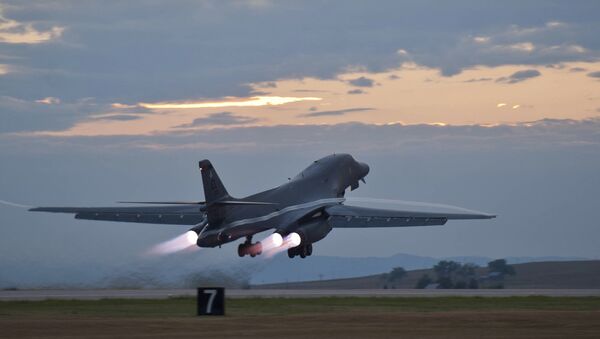When manufacturing company Rockwell built the B-1 in the late 1970s, it was designed to fly low and fast: a supersonic, terrain-hugging zip in below Soviet radars to deliver a nuclear strike, then zip out again. However, amid continual repurposing, the bomber has fallen into a new role it was never envisioned for: close air support in which it loiters over battlefields for hours.
The mission has put unprecedented stress on the advanced aircraft, and Air Force brass are considering changing how they use the bomber in order to minimize wear and make the Lancer fleet last until its scheduled 2036 retirement date.
USAF Global Strike Command spokesman Lt. Col. David Faggard told Military.com Sunday that one of those options is for pilots to stop using the jet’s special low-altitude terrain-following capability, a program called TER FLW, during training missions.
"We're closely working with aircrews, maintenance, industry engineers and combatant commands to identify and determine what, if any, changes may be made as we balance operational necessity today with the longevity of the B-1 airframe for the future," Faggard said. "We're building a viable transition plan to get us from the bomber force we have now to the bomber force of the future. We can change tactics - altering, bringing back or avoiding any tactics or procedures as necessary on any bomber at any time in the future."
TER FLW projects a special radar directly in front of the aircraft, reading the terrain and adjusting the plane’s flight computer to safely traverse it at minimal altitude. It’s activated with a simple switch on the plane’s avionics.
Just how low? Check out this clip of a Lancer traversing a ridge bifurcating low plains while in TER FLW mode:
"Low-level is hard on aircraft. There's a lot of forces - atmosphere, turbulence, all those things,” Alan Williams, deputy program element monitor of Global Strike Command’s B-52 Stratofortress program and a former B-52 pilot, told Military.com.
Air Force Gen. John Hyten, the head of US Strategic Command (STRATCOM), told the Senate Armed Services Committee in July the Lancer “is the workhorse of the Air Force today,” but that this steady use has led to just a fraction of the USAF’s 44 B-1Bs being available for missions.
"We saw issues in the B-1 because we're just beating the heck out of them, deploying them, deploying them. And so we had to pull back a little bit and get after fixing those issues. And the depots can do that if they have stable funding," Hyten said.
The dark gray swing-wing bomber made the switch shortly after the US war in Afghanistan began in late 2001. One pilot who flew during that time, Jordan Thomas, told the Washington Post for a 2015 story that immediately prior to the war, a congressional staffer had “asked whether it was true that the B-1 wasn’t able to fly over high mountains like in Afghanistan, which he’d read somewhere. I wrote back, ‘We can fly over the mountains of Afghanistan, but why on Earth would we?’”
However, the bomber was quickly “proving its worth,” as the Los Angeles Times put it in December 2001, with its ability to loiter 20,000 feet over the battlefield for a long time and carry incredible amounts of weaponry. Retired USAF Lt. Gen. David Deptula told the Post that a single B-1B can carry as many bombs as 40 carrier-based attack aircraft.
In an effort to embrace this new role, Boeing developed for the Air Force the option of placing a variety of close air support weapons, including an autocannon, machine gun, rail gun or even a laser, inside the plane’s internal weapons bay, Sputnik reported last year.
At the same time, the Lancers have also been tested as an “arsenal plane” platform for new long-range cruise missiles, including the Joint Air-to-Surface Standoff Missile (JASSM) and its variants, as well as the Long Range Anti-Ship Missile (LRASM) and the hypersonic Air-Launched Rapid Response Weapon (ARRW). This mission profile would fit the suggested reduced-stress recommendations Faggard described.



